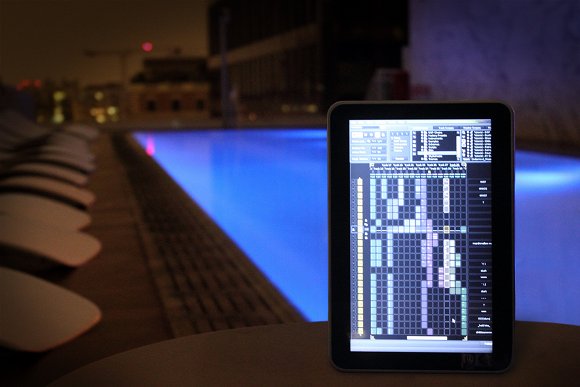
Touch form factors make sense for music creation on the go: a mobile tablet with finger-based interface seems ideal for performance and travel. In the fast-evolving hardware, though, it’s tough to work out exactly what will be a hit and what will be a flop. Multitouch tablets have splintered in two – consumer-centric, inexpensive tablets like the iPad and Android tablets gravitate at one end, as higher-powered tablets are reserved for the business market. Worse, the entire computing industry is choosing battery life over all other factors, which doesn’t jive well with audio. (Almost everything you do to improve audio performance saps power. Doh.)
But that could leave opportunities for computer makers to cater to musicians. Here’s just one example, and it lies right at the convergence of next-generation, Linux-based operating systems, touch-centric design, and more efficient mobile computing.
Indamixx, who have previously done Linux-based laptops using tablets and netbooks, are now readying a multitouch tablet based around the current-generation, dual-core Intel Atom chipset. The Linux OS means you can run the terrific tracker-for-the-rest-of-us Renoise, as well as a variety of free software; that’s Renoise pictured as the Indamixx tablet hangs out by the rooftop pool of LA’s The Standard last weekend, for its public debut. (Indamixx hosted a Renoise-themed blowout party.)
Early specs: single core N450 Atom (prototype only; final model is planned to be dual-core), 2 GB RAM, 3 USB ports, 1 VGA port, 1 Ethernet port, analog audio I/O. That’s much like what you’d find on a netbook, and it’s a far cry from the computing power of a desktop or laptop. But with optimized software, it could be ideal for mobile production and performance. (Even with optimization, tablets, by contrast, can’t compete on computing horsepower – and they’re not really set up for terrific low-latency audio performance, either. Oh, and you get better hardware support from traditional Linux operating systems than things like iOS, Android, and Chrome OS.)
More details came out on the Renoise forum. The other surprise there: while Renoise is largely a QWERTY-centric experience to most of us, Indamixx tells us the touch approach works very well. I’ll believe it when I — uh, touch it — but I’m interested how that works.
The product will launch May 11, 2011, but we should have more info before then, and we’ll visit them at NAMM.
If you’re not in love with the hardware, you’ll be able to use the OS with your own rig, too, if you prefer to build or buy your own system. Dual-booting to Ubuntu will also be an (unsupported) option.
I got some further details on the direction they’re going from the source.
Whereas the Transmission custom distro Indamixx has used in the past was based on Ubuntu and Debian, the new OS is MeeGo, the distro with powerful backing from Intel and Nokia. It’s still Linux; it even uses RPM as its package manager. But it’s probably the most mobile-centric of the mainstream Linux distros. (By the way, Linux fans, don’t sweat those details too much – the development environment for MeeGo runs on Mac, Windows, and other Linux distros, and software ports pretty easily between them.)
I’m not thrilled about the touch digitizer on the development unit – the serviceable but unspectacular MosArt sensor used on Asus’ T91MT netbook – but it sounds as though that’ll change to something much better before this ships. (It should be just fine for development purposes.)
The choice of MeeGo, though, is certainly interesting. Indamixx lead developer Gabriel Beddingfield and founder Ronald Stewart are raving about how the OS feels and operates, and say they’re getting terrific performance out of the system. I’m eager to try it first-hand. Gabriel has more to say:
CDM: How does this differ from Transmission as we’ve seen it in the past?
Gabriel: It’s effectively a reboot of Transmission. All packages
currently in Transmission will be ported over. The end user-will reinstall this MeeGo-ized Transmission on their device.
Unlike Transmission 4, there will also be a Live CD / Live USB version that you can preview before installing.
Why MeeGo?
Unlike any Linux distro we’ve found so far, MeeGo is from the ground-up about multi-touch, portable devices that compete with iPad and Android. The main “desktop” user experience is sharp, fast, and finger-friendly.
Our departure from MeeGo is in tuning it for audio. Out of the box, Transmission will be more concerned with a high quality, low-latency audio rather than preserving battery life. However, our experience with the Atoms shows that battery life is pretty good, too.
Multi-touch support will come by way of Qt’s Multi-touch framework… which is expected to have a relatively smooth upgrade path to Xorg 1.10 or 1.11 when Xorg officially supports multi-touch (Q1/Q2 2011). [Note that this is a different solution than the one that Ubuntu is providing.]
How will users install their own software?
MeeGo is also working heavily for app-store integration. So, users will be able to install free and commercial apps from Intel, Ovi, or other app stores. MeeGo’s architecture will ensure that the apps will work on this device.
In addition, it’s still Linux… and so users are still able to hot-rod their systems.
What’s the multi-touch digitizer hardware?
Will be capacitive, and will at least be dual-touch.
Right now we’re developing on an eGalax dual-touch that appears to have some pressure-sensitive features (can differentiate between a mouse-over and a click), and we’re also using a Cando dual-touch that is a little more primitive.
Stay tuned for more — consider this a teaser for now. I’ll also have a look at a number of hardware options that take another approach to touch and performance, offering flashy multi-touch tables that make you look sexy onstage. Stay tuned here.